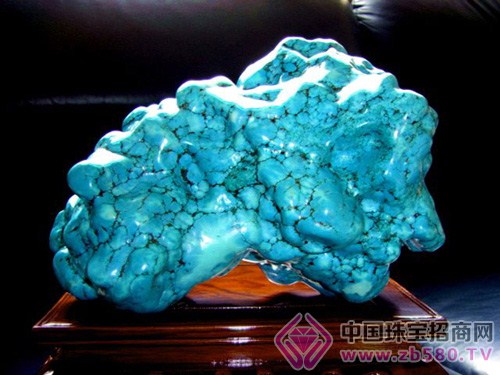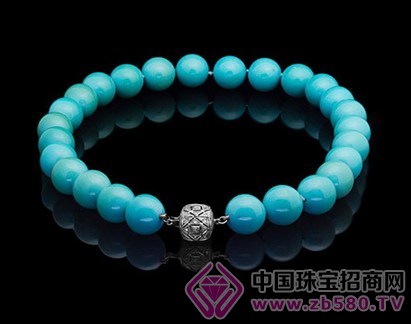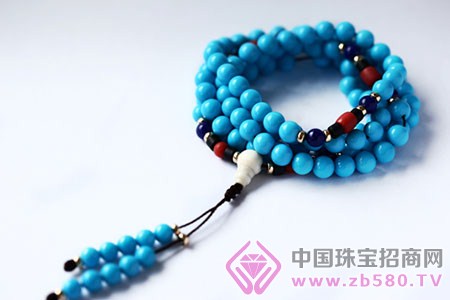What is the reason behind the "insane" of turquoise? What is the future appreciation space? How does the quality of the market bring about quality problems that are difficult to distinguish between true and false? Recently, experts from the Guangzhou Geological Survey, science and technology consultants, naturalist Liu Jinshan, and the former secretary general of the Shandong Jewelry Association, Li Tongyi, said in an interview that the turquoise has almost reached the top after several rounds of price increases. Collections and investments need to be extra cautious.

"Heavenly Gem"
Once included in royal supplies
Turquoise is also known as "Songshi". In 1927, Zhang Hongjun, an old Chinese geological community, explained in his famous book "Shi Ya" that "or resembling a pine ball, the color is nearly pine green", because the natural output of turquoise is often tuberculous and globular. The color is like the green of pine trees, so it is called "turquoise".
Turquoise is one of the ancient jade stones, because of its beautiful color has become a gemstone of the East and the West. In ancient Mexico and ancient Egypt, it was regarded as a mysterious thing, and the products were used as amulets and funerary objects; in China, turquoise and Hetian jade, Dushan jade, and jade jade were also called "four famous jade".
Archaeology found that the history of mining and utilizing turquoise in China can be traced back to the Neolithic Age. Turquoise was found in the Yangshao and Banpo cultural sites. Later, in the long-term "Wu Yu" and "Shen Yu" eras in China, turquoise has always played an important role. Many rituals of the gods and gods unearthed from cultural sites such as Hongshan, Longshan, Liangzhu, Daxi, Majiayao, Sanxingdui and Erlitou are inlaid with a large amount of turquoise. From the Spring and Autumn Period to the Qin and Han Dynasties, the use of turquoise was more extensive, and even became a national gift of diplomatic alliance. In the Qing Dynasty, turquoise was called “the jewel of heavenâ€, and it was listed as a royal special product and a monopoly jewel because of its “hue in the skyâ€. In the Qing Dynasty, the Qing Dynasty Dynasties Pictured: "The emperor is decorated with beads, but the Temple of Heaven uses lapis lazuli, the altar uses amber wax, the altar uses coral, and the moon altar uses turquoise."
Mineral research is best in blue
Modern mineralogical studies have found that turquoise is an aqueous copper aluminophosphate. Liu Jinshan explained that turquoise is infiltrated by surface water into copper, aluminum and phosphorus-bearing rocks, and the ore-forming solution formed is precipitated under certain conditions, so that the pigment metal ions such as copper and iron are formed from blue and green. To light yellow, light green and various colors.
Turquoise evaluation and purchase are based on color, texture and blockiness. “The source of turquoise color depends mainly on the content of copper and iron. The color of copper is more blue, the color of iron is more green, the best is blue and dark blue. Usually, sky blue and blue green are high quality products, green and Gray-green is the second, light white is the worst, but it can be artificially colored to make it a turquoise imitation. After a long period of precipitation, the turquoise is colorful, but now the aesthetics are all about 'pure'. I prefer natural aesthetics. , biased towards rarity." Liu Jinshan introduced.

The Chinese arts and crafts industry generally divides the turquoise into three grades:
Turquoise-level: The color is bright blue, the color is pure, uniform, strong, translucent to slightly transparent, and the surface has a glassy feel. The texture is dense, delicate, tough, without iron wire or other defects, and has a large block;
Secondary turquoise: the color is dark blue, blue green, emerald green, strong luster, slightly transparent. Tough texture, few iron wire or other defects, medium block;
Three-level turquoise: the color is light blue or blue-white, light yellow-green, the gloss is poor, the texture is hard, the iron wire is obvious, or the defects are more, the block size is different.
According to the texture, it is divided into porcelain pine, iron wire porcelain pine, hard pine and facial pine (or foaming pine).
The porcelain pine ore body is tightly combined, the texture is fine, the color is uniform, and the blockiness is small. After cutting and polishing, the porcelain texture and luster can be exhibited; the iron wire porcelain pine ore body and the characteristics of cutting and polishing are basically the same as the porcelain pine, but only Jade contains black or maroon texture, called iron wire. The finer and clearer iron wire is the top grade. The output of these two types of porcelain pine is rare, and it has great collection value. It is often seen as hard pine in the market. The combination of ore body is relatively compact, the texture is relatively delicate, the color is rich, and the block is uneven. After cutting and polishing, it presents oil. Wax texture and luster, soft color. When purchasing the finished product, the color and texture should be unique, the surface gloss should be soft, and the blockiness should be high. The value of the foamed ore body is loose, the texture is soft, the color is dim, and all colors have gray-white tone. Knives can even be swiped with nails, and some face can even be written as "chalk" on the blackboard. This kind of turquoise can not be used as jewelry. In ancient times, it was ground into powder as a pigment. However, in the increasingly scarce of turquoise, many merchants injected it, waxed it, dyed it, and then made it into jewelry. High-quality, uniform color turquoise is mainly used to make curved face, chest, earrings and so on. For general quality, it is used to make necklaces, bracelets and costumes of various styles.
In grams
Suspected speculation
Turquoise and other stone materials symbiosis, low purification, often 10 tons of ore can only get about 1 kg of turquoise rough, the processing rate is not high. But even so, the value of turquoise has not been optimistic compared to jade stones such as Hetian jade and jade. Until recently, as the domestic turquoise mines have been shut down, the market is in short supply, and the increase of turquoise is obvious. From 2008 to 2009, the price per gram is more than ten yuan to several hundred yuan per gram, which is far higher than the price of gold. . In the jade market, taking the American porcelain pine pendant as an example, the good quality is about 600 yuan to 800 yuan per gram, the middle and high grade is about 4 to 500 yuan per gram, and the mid-range is about 200 yuan per gram.
A senior collector who has been paying attention to the turquoise market has complained to reporters that the turquoise has risen a bit to make it difficult for collectors to understand and tolerate it: "One or two grams of a ring is more than two thousand, and the most expensive is up to 800. One gram of multi-component, of course, this ring fabric is pure natural color, uniform color, beautiful sky blue, no optimized natural ore. The gloss is good, the color is blue, the basic price is four or five hundred yuan per gram, the ordinary one hundred two yuan one Ke, the cheapest is also 40-50 yuan to 7080 yuan a gram. I look at a turquoise turtle less than 10 cm high, count it down, even for four or five thousand yuan. Previously a small carving piece One or two thousand yuan will be able to win, and now it will cost one hundred thousand yuan."
Analysis of the reasons for the price increase of turquoise, Li Tongyi believes that not only turquoise, the miscellaneous categories in the collection market have risen very quickly, "because the big items in the collection, like paintings and calligraphy, can be said to have risen to the end, investment space is getting more and more Small, so the market began to speculate on some 'small things'." Moreover, compared to high-priced collections such as porcelain, some low-end jewels and jade are expensive even if they are single, but they can buy one for one hundred and twenty thousand yuan. Fine, "and such a price certainly can not buy a boutique painting."
Liu Jinshan believes that turquoise is concerned about the wenwan market. The fundamental reason is that it is connected with the Chinese jade culture. At the same time, its bright colors have always been an important material for jewelry making and setting. Some international luxury jewelry brands also pass high-end. The craft has greatly enhanced the artistic value and luxury of turquoise, making it increasingly active in the jewelry market. However, Liu Jinshan also pointed out that in terms of gram price and such a high increase, there is still market speculation: "Ruby, sapphire, diamond, because of its rare price in grams can be understood, turquoise is a price, it is still a kind of speculation." For the market The concept of scarcity of resources, Liu Jinshan denied the distribution of resources from turquoise. "There are not many turquoise producing areas. China is concentrated in Hubei, Shaanxi, Xinjiang, and the United States, Russia, Egypt, Iran, etc. from all over the world. Speaking, this jade species is relatively early mining and development, but despite this, I still don't see the shortage of resources in turquoise."

High position
Risk of follow-up investment
Compared with the past price, today's turquoise is already running at a high level, so how much room for appreciation in the future? Some merchants broke the news. Although the price of turquoise has risen sharply, the number of people who buy relatively large ornamental stones has been greatly reduced. However, the number of people who buy jewelry and miscellaneous items has increased, and the total turnover has not risen. However, he also admitted that it is still time for Turquoise's current high price to be recognized by consumers.
In this regard, Liu Jinshan said that in the people's understanding, white jade, jade, red sapphires, emeralds, cat eyes and other precious gems are precious, follow the trend, invest in turquoise is at risk, "still buy your favorite varieties, buy If you can't afford it, you can buy less and buy a medium-sized product." Liu Jinshan took the example of “Huanglongyu†in the market in the early years, and suggested that people who enter the turquoise collection should polish their eyes. “In the past, someone spent two or three million yuan to buy 'Huanglongyu'. I was not optimistic at the time, because from a geological point of view, 'Huanglongyu' is a kind of water-containing silica, and silicon is more abundant on earth. The elements will definitely find similar or even better mineral deposits in more places in the future. The rareness of resources and the rarity of resources are the key to evaluation."
In addition, the scarcity of turquoise is relatively speaking. At present, the low-end turquoise scarcity in the market is not outstanding. Once this kind of turquoise is started, it will bear the pressure of difficulty in appreciation and difficulty in realizing it. What is really scarce is the natural raw mineral porcelain, as a kind of non-renewable resources, the number of fine turquoise will be less and less.
In Li Tongyi's view, even in ancient times, turquoise was not a particularly precious gem. Like agarwood and beeswax, the price was very close to the people. Now, after several rounds of price increases, it has already reached the top, and it can be "leaked". Opportunities are minimal, and he also recommends that collectors should observe more, exercise their own vision, and carefully start to find the right position.

Collection Raiders: Identification of advantages and disadvantages to see the iron line
At present, the non-natural ore turquoise in the market is mostly “optimizedâ€. Liu Jinshan said that although there is no A, B, and C goods in the research and market, the fact that A, B, and C goods have appeared in the same way as jade: the natural, untreated can be called A. Goods; after the manual optimization is B goods; if the artificial color on the basis of optimization makes the color bright, uniform is C goods; artificial synthesis can only be called fake. Li Tongyi also revealed that in the wenwan market across the country, cheap "turquoise" can be seen everywhere, some are through injection molding, glue filling, dyeing, and some are imitation products, natural pines are not even a single.
How to identify whether turquoise has been artificially processed? According to experts, the skill that ordinary consumers can easily grasp is to observe the color. "In theory, the natural structure is dense, dense, high hardness, and heavy, but this feature is not easy to use in practical operation. The best screening method is color, synthetic and optimized turquoise color is uniform and bright. The natural turquoise color is uneven, and it can generally be made into a ring face with a small area. The price is also the most expensive. Most of the turquoise is often motley, speckled, and iron wire."
In addition to the color, there is also a way to judge the pros and cons and the authenticity through the iron wire on the turquoise. The turquoise iron wire is formed by limonite. The boundary between the natural black iron wire and the blue and green color is often clear, the grain is naturally fine and continuous, and the synthetic and fake iron wire is not so fine. The texture is blurred and the border is not clear. The finer the iron wire, the higher the quality of the turquoise; on the contrary, the thicker, more dense, and denser the iron wire, the lower the grade.
In addition, due to the porous porosity of the turquoise, it is necessary to keep away from the pollutants during the wearing process and avoid contact with oil, rust, acid, etc., in order to prevent the pollutants from penetrating into the gemstones. Turquoise is also afraid of high temperatures, can not be directly fired and direct sunlight, long-term exposure to sunlight will cause cracks and fading of turquoise due to water loss, too high temperature baking will make the turquoise brittle and brittle.
Microfiber Sponge Polishing Pad
microfiber sponge polishing pad
Soft, easy to scrub and without crumbs Comes with pocket for easier hold,
Use for applying and removing wax Washable and reusable,Durable, one sponge can wash and wax your vehicle up to 8 times
diameter:12cm,thickness of sponge:1.5cm
use for car polishing,cleaning,drying
Function:Soft Wash
Feature:Absorbing
Microfiber Sponge Polishing Pad,Microfiber Cutting Pad,Car Polishing Pads,Meguiars Microfiber Pads
Shijiazhuang Tangju Trading Co., Ltd. , https://www.tangjutextile.com
